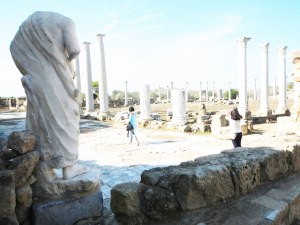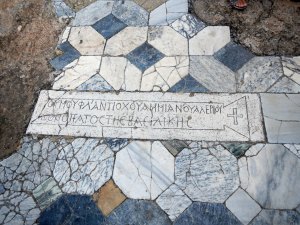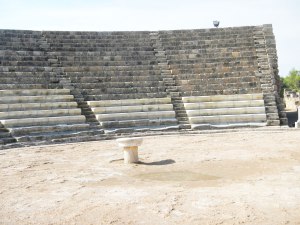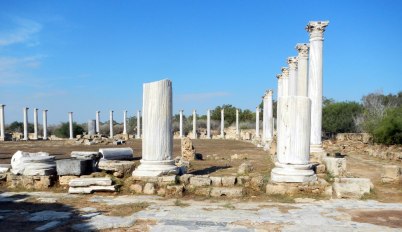Being buried beneath sand for more than a thousand years saved Salamis from destruction. The ancient city originates back to 1100 BC – after the Trojan War – when Salamis was the capital of Cyprus. Coins discovered from the Middle Ages around the city’s basilica indicate there were still inhabitants living in the ruins up to around 1300 AD.
Due to Salamis’ location along the sea, it became an important trading center once the “dark ages” of the Mediterranean world came to an end around the eight century BC. In 648 AD after yet another Arab raid, the remaining inhabitants had had enough and finally moved to what would become Famagusta.
The Salamis archaeological site is regarded as the island’s most spectacular; not only because of the extensive ruins, but also because of its extremely well-preserved state.
Ancient ruins in Europe were considered “free-for-all quarries” for builders of medieval castles. It wasn’t until the late 19th century that various governments began forming antiquities departments and banned site looting. Therefore, Salamis was not immune from the looting of statues, marble columns and pre-cut stones.
According to historical accounts, the city was built and destroyed several times due to earthquakes. The ruins evident today are mostly of the Roman time.
Three major areas of the Salamis archaeological site uncovered consist of the gymnasium, theater and baths. On the other side of town are ruins of houses, the basilica and temple of Zeus, all of which encompass a large area and are still being studied. Excavation stopped in 1974.
Gymnasium
 This public structure – built during the first century BC – is where young Greek men gathered for physical workouts and cultural training. “Every year one person from the town was elected to financially support the gymnasium and provide the athletes with olive oil,” Elani, our tour guide, explained to us.
This public structure – built during the first century BC – is where young Greek men gathered for physical workouts and cultural training. “Every year one person from the town was elected to financially support the gymnasium and provide the athletes with olive oil,” Elani, our tour guide, explained to us.
Before the games, the athletes would slather their bodies with olive oil. The popular games then took place in the large gymnasium, an open courtyard surrounded by column arcades.
Two swimming pools occupied the two ends of the eastern colonnade just prior to the bath area.
A marble inscription on the floor leading to the Gymnasium is dedicated to Ptoleme V Epiphanes who ruled from 205-180 BC.
Baths
I found the bath area the most interesting part of the ruins, and this area has still not been fully excavated. The Roman baths were customarily located near the gymnasium, just as they are at Salamis. Here we visited four large rooms known as the frigidaria (cold room), tepidarium, caldarium (hot water baths) and sutatorium (sweating rooms).
People gathered in the first bath entry room to socialize and conduct business deals – a type of meeting place – while the second room was strictly for washing and bathing.
The first bath room – the frigidarium – was the room with cold water. Here the slaves or workers provided massages. From here, the men went to the gymnasium to work out before returning to the other rooms of the baths.
 The baths were lavishly decorated with marble statues, colorful mosaics and mythological paintings. The entire area was encompassed in rich marble.
The baths were lavishly decorated with marble statues, colorful mosaics and mythological paintings. The entire area was encompassed in rich marble.
After visiting the frigidarium, the men proceeded to the tepidarium and caldarium. The tepidarium room was for medium hot water while the caldarium for hot water.
It was interesting to learn how they heated the water. They used a system known as ebocostas. With charcoal they produced hot air, which passed between tubulars; the same system used for cold water in the frigidarium. Some of the tubular system is still evident.
The sutatorium was the steam room, where we saw the brick pillars that the hot air passed through. When the hot air passed under the marble floor, there was a system in place that heated the water. The small sutatorium needed only a small amount of water; when the water evaporated, it caused steam. Here men would sit and sweat before entering the “cool down” frigidarium room once again.
Above the arch in one of the bath rooms was a partially restored fresco painting recounting a folktale. The story, as told by Elani, goes something like this: Before an expedition, Hercules asked his friend Elus to fetch water for the boat and journey. When Elus reached the well, a beautiful nymph placed a spell on him. (The painting depicts the moment the nymph – a woman with black hair and water dripping from her hand – casts the spell, and Elus cannot move.)
 Meanwhile, Elus has been gone longer than it should have taken, and Hercules realizes something must be wrong. He goes in search of his friend, finds him paralyzed in place, and somehow manages to get him back and free him of the spell.
Meanwhile, Elus has been gone longer than it should have taken, and Hercules realizes something must be wrong. He goes in search of his friend, finds him paralyzed in place, and somehow manages to get him back and free him of the spell.
Theater
Of the three excavated theaters thus far in Cyprus (Kourion, Soli and Salamis), this one is the largest. When it was first constructed during the first century BC, the theater had 50 rows of seats (now there are 22) and accommodated 15,000 spectators (now it seats 6,000). Elani stated that a town’s population back then was determined by multiplying the theater’s capacity by four. Thus, Salamis’ population was about 24,000 when the theater was constructed.
Roman style theaters had a half circle orchestra with an auditorium arch of 180 degrees. In the center was the altar. Prior to a performance, the townspeople placed offerings to the god of entertainment upon the altar.
Two centuries later, a three-foot high wall was built around the orchestra and filled with water to provide sea re-enactments. Earthquakes destroyed the theater and it was not rebuilt until 1959 by the Dept. of Antiquities. It is used today for musical performances.
Elani pointed out the two first rows of seats, which are the originals. These seats were reserved for the VIPs of the town. The remaining seats – different color and shape – were reconstructed.
Strewn around the Salamis site are many statues, with the majority having been relocated to an archaeological museum. All had one thing in common: They were missing their arms and heads. There were two reasons for this, according to Eleni.
First, the Christians could not accept that there were still people who believed in the 12 Gods of Olympus; so they destroyed many of the statues as a type of retaliation. Secondly, due to the many Arab invasions, when statues are toppled obviously the first pieces to break are those not directly attached to the body – the arms and heads.
The folklore and innovation associated with Salamis, and the baths in particular, are almost as amazing as the actual ruins. I can only imagine the liveliness of the games, the seriousness of the “business” meetings, and the laughter and applause ringing the theater that certainly was emitted from this ancient city.

